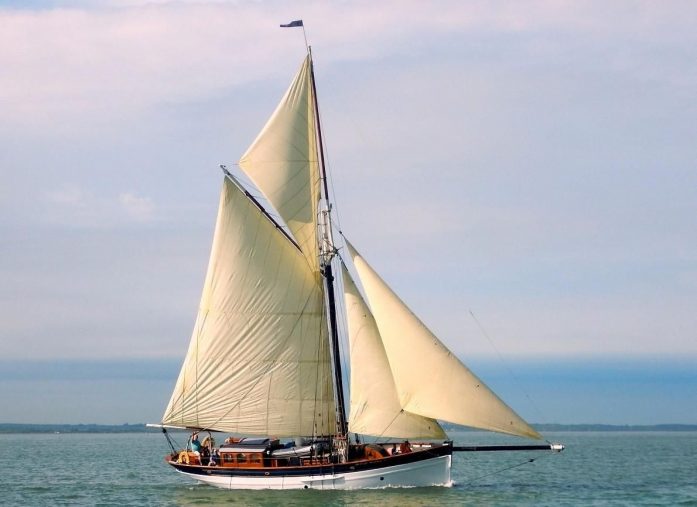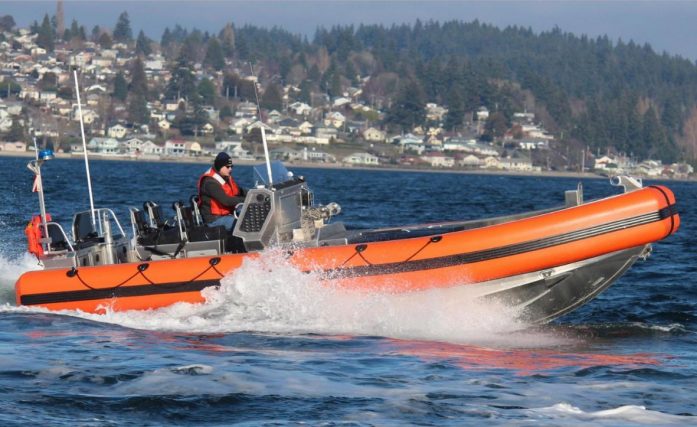The cutter is usually one that cuts, but here, is about boats that cut the waves faster than others. There are three types of cutters: the normal ship’s boat for carrying stores or passengers, the single-masted fore-and-aft rigged sailing vessel, and the small armed vessel in government service. All these three are called cutter. On Wikipedia, we find more than three types. Anyway, we have to remember that any cutter is a boat designed for speed.
The Sailing Cutter
This vessel is one of several types of sailboats. Traditionally the sloop rig was a rig with a single mast located forward of 70% of the length of the sailplan. In this traditional definition a sloop could have multiple jibs on a fixed bowsprit.
You have below a gaff cutter with a gaff sail (the quadrilateral one below the gaff), two headsails, and a gaff topsail above the gaff.

Gaff Cutter
[source: yachtworld.com]
The cutter rig, especially a gaff rig version where the sails aft the mast were divided between a mainsail below the gaff and a topsail above, was useful for sailing with small crews as the total sail area was divided into smaller individual sails. These could be managed without the need for large crews, winches, or complex tackles, making the boiat especially suitable for pilot, customs and coast guard duties. For example, a pilot cutter may only have two people on board for its outward trip—the pilot to be delivered to a ship and an assistant who had to sail the cutter back to port single-handed. The cutter sailing rig became so ubiquitous for these tasks that the modern-day motorised vessels now engaged in these duties are known as ‘cutters’. – cf. Wikipedia
Coast Guard
For example, United States Coast Guard Cutter is the term used by the U.S. Coast Guard for its commissioned vessels. They are 65 feet (19.8 m) or greater in length and have a permanently assigned crew with accommodations aboard. They carry the ship prefix USCGC.
US Coast Guard orders the horizon-IV cutter boats to deliver boarding teams to vessels of interest during search and rescue; law enforcement; ports, waterways and coastal security; and defense readiness missions.
They are 26 feet long and have a top speed of 40 knots. Compared to the OTH-III (their predecessors), they feature increased cargo space and seating, higher speeds, and compatibility with both stern and side-davit launch and recovery systems.

Cost Guard pmeumatic
[source: navaltoday.com]
I had a photo with the ship’s prefix and everything, but it wasn’t clear enough, so I have illustrated this type with a very similar one.
This article has just an educational and informative role. It is far from being exhaustive.
If you like what you read, please subscribe to this blog by completing the form. If you want to help more, start by following us on Twitter, and like our page on Facebook. You don’t know what good things may happen. To lighten your day, check our pins on Pinterest, we can be friends there too. Oh, and if you need a really good looking blog attached to your site, or just for fun, to express your feelings more competitively, read this Own Your Website offer! Thank you very much.

Sorry. Henry Keppel
Hi
Your site is really interesting. I’m trying to find out what type of ship’s boat is a tope? I found this word in Henry Keooel’s book, The expedition to Borneo of HMS Dido for the suppression of piracy….
I’m sorry, but I have no idea if this ‘tope’ exists as a proper type of boat. It seems that “The tope is Britain’s largest inshore native shark, and grows to a maximum size of around 2 metres in length and 95lb in weight.” (cf. Just Fish)
Maybe it’s a slang term? It is definitely British, anyway.
as a future naval architect and engineer, i really appreciate the effort that you put onto explaining all this information in detail.